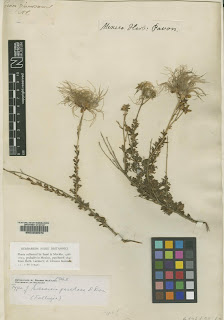Having a lazy Sunday morning and a recent FB post about Apache plume tickled my curiosity. I'd never really given much thought to its authority, the part of a scientific name that follows the binomial and identifies the author(s). Wikipedia gives "Fallugia paradoxa (D.Don) Endl." but there's more to the story than just David Don and Stephan Endlicher naming this striking plant back in the early 1800's. Looking at Kew's Plants of the World entry reveals that the full authority is (D.Don ex Tilloch & Taylor) Endl. ex Torr. That's a mouthful and needs some serious decoding.
It was time to get another dose of caffeine and take a deep dive into taxonomic nomenclature and botanical history.
It appears that specimens of Apache plume made it back to taxonomists in Europe in the early 1800's. As best I can tell from James Henrickson's 2001 article, the first Apache plume specimens collected by Europeans were from the M. Sessé and J.M. Mociño expeditions* (1788-1803). Their materials were processed by José Antonio Pavón Jiménez and labeled under his name. The location from the label can be viewed on Google Maps.
 |
| Digital image of the type specimen in the British Natural History Museum |
Somehow** one of them found its way to London and the Scottish botanist David Don, the librarian of the Linnaean Society and curator of the Lambert Herbarium, must've come across it. Don was the son of a curator of the Royal Botanic Garden in Edinburgh and had a keen eye towards New World plants. The list of taxa that he named is lengthy, even by 19th century standards. (As an aside, he spotted a specimen of the California coast redwood and named it Taxodium sempervirens. Later this taxon was placed in a separate genus that we now know as Sequoia sempervirens.)
But I digress.
Don named the Apache plume Sieversia paradoxa, placing it in a genus of the rose family found in northwestern Asia. Richard Taylor and Alexander Tilloch, the two editors of an early natural history publication, the Philosophical Magazine, picked up Don's work and officially published it in their journal in 1824. In the obscure world of botanical nomenclature, this is shown as Sieversia paradoxa D.Don ex Tilloch & Taylor.
Here's ex decoded: "The word ex is mainly used in circumstances in which there is an author (or authors) who only contributes the name of a taxon, while it is a different author (or authors) who actually validly publishes that name. In these cases, the author(s) who ascribed the name is separated from the publishing author(s) by ex."
OK so far. Taylor and Tilloch took Don's work and get partial credit, thus assuring their 19th century version of botanical immortality.
Apparently there were a number of illustrated specimens floating around Europe at this time from the Sessé and Mociño expeditions. The famous botanist de Candolle obtained their drawings, saw Apache plume, and placed it in the Rosaceous genus, Geum (common name avens), with the specific epithet of cercocarpoides (probably due to the fruits' similarity to those of Cercocarpus). Nicolas Charles Seringe, a French medical doctor and botanist teaching in Lyon, published this in de Candolles' Prodromus in 1825 as Geum cercocarpoides DC. ex Ser.
Sorry, Nick, you're too late. Your new Geum name is a synonym for a previously validly published name.
In another twist, I see that the well-traveled German botanist, Ernst Gottlieb von Steudel, must've seen the same specimen that Don worked off of. In 1840 von Steudel placed it in Geum also, giving us Geum paradoxum. The change from paradoxa to paradoxum was due to the Latin gender of the generic names.
Nice try, Ernst, but our Apache plume isn't an avens.
So where does Fallugia come from and what's with the parentheses and Endl. ex Torr.?
In 1840 a fellow named Stephan Endlicher noticed the disjunct between our southwestern Apache plume and the rest of Sieversia. He created the genus Fallugia to segregate the taxa. Wilhelm Gerhard Walpers in Germany saw one of the New World specimens (not Don's original) and published the name Fallugia mexicana Wald. in 1840. Had he known that Don had already had created a valid specific epithet, he could've saved us some time.
Meanwhile, back in the U.S., John Torrey was busy working with the likes of Asa Gray to process the torrent of material coming back from expeditions in the western territories. Specimens collected on expeditions led by Major Stephen H. Long (1820) and John C. Frémont (1845) were revealing the botanical riches of the American west.
In any event, Torrey recognized that Don's Sieversia paradoxa needed to be placed in Fallugia. That gives us Fallugia Endl. ex Torr. However, when taxa get shuffled around into new combinations, the original source of the name is attributed to the first author(s) by placing their names within parentheses to give credit where credit is due. So Don's paradoxa was combined with Endlicher's Fallugia by Torrey, giving us the wonderfully complex Fallugia paradoxa (D.Don ex Tilloch & Taylor) Endl. ex Torr.
Whew! What a roll through botanical history, all wrapped up in a scientific name.
_______________
* Funny how Wikipedia doesn't have any references on these explorers. #justsaying
** There seems to be a connection between Pavón and Aylmer Lambert, the prodigious botanical collector of the day. Lambert was known to track down specimens to add to his collection of 50,000 plants.



